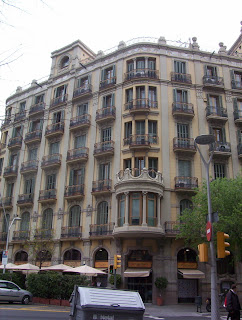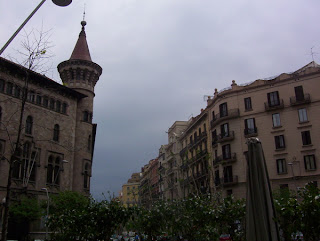L’Eixample

After more than a week of negligence, brought about by loads of work and a short surf trip, I am back to finally deliver a treatise on my current neighborhood, l’Eixample (the pronunciation of which I can only begin to explain: the X makes a sort of zh sound, and the whole thing sounds French).
Named for the Catalan word for “Extension,” (Catalá often sounds French), this was a planned expansion of Barcelona’s original, old city (Ciutat Vella), essentially filling the space of Growing Barcelona and the outlying towns of Grácia and Sants (which are now Barcelona neighborhoods).
Conceived by architect Ildefons Cerdá in the mid-19th century (let's call him The Fonz), it’s distinguishable by the fact that the corner of each block is cut diagonally (originally to allow space for a horse-and-carraige to turn around). The resulting, especially wide intersections give each monolithic block a rather imposing stature, as if the perspective makes you think the buildings are bigger than they are (which is pretty big). The full scale of The Fonz's plan was never realized, but you can see what he envisioned in the below illustration, bearing in mind that most of what exists today is found in the lower left half of the rectangle.

Now that I’ve gotten the Wikipedia stuff out of the way….
I mentioned before that my entrance to the neighborhood was heralded by Gaudi’s Casa Batlló, but the truth is there’s a lot of great architecture here, and even several weeks into my stay I often find myself glancing upward when I walk the streets, eyeballing the fine masonry, and marveling at the notion that buildings could be beautiful and functional at the same time (not that strip malls shouldn’t grace the American landscape…).


All of the pictures I’ve taken in l’Eixample were within 2 or 3 blocks of my place, many within a single intersection. It’s difficult to capture in two dimensions.



As it turns out, the location is quite central to all things worth seeing in Barcelona, which is another way of saying I haven’t really made it out of a walkable radius. But, really, why bother? If I don’t want coffee from the place across the street, I can get it across the street from any number of landmark buildings. Also across the street is essentially a permanent farmer’s market, where fresh produce, charcuterie, fresh baked bread, artisanal cheese, fresh seafood and recently butchered meat may be purchased from a number of independent booths. Underneath that is a basement grocery store where all the packaging (including familiar American brands) is written in Catalá as well as Spanish, which I mention because that particular language is pretty much spoken in Barcelona and the surrounding province and few places else in the world.
In fact, the street signs, advertising and assorted storefronts wear Catalá words, consonant combinations like –tg and –bt, borne like blunt instruments against my already stunted comprehension. Fortunately, many signs (and menus and ingredients lists) feature a second line written in Castilian, which is the word exclusively used to refer to what I’ve always known as ‘Spanish.’ I guess if you try to tell a speaker of Catalá that Spanish is not the language he grew up speaking as a native Spaniard, he might take offense.
Because tourism has blossomed since Barcelona hosted the Summer Olympics in 1992, there are also a lot of signs and menus with another, English translation. This, and the continued willingness of the local populace to see through my cunning attempts to cover what remains a slow, stumbling accent, has prevented me from getting too much valuable practice at Castilian, though I have taken to reading the local paper, and even managed to watch a movie that had been dubbed into Spanish. Granted, that movie was the comicbook Greek war flick, 300, so it wasn’t too hard to keep up, even with no subtitles. (Okay, that –bt makes some sense, but what do you to when it looks like this—‘subte?’)
I am approaching the four-week mark in this country, though, and a lot of the local culture and language has settled in. I know now that drip coffee is hard to find, so I betray myself daily by ordering the Café Americano. I understand what I might get when I order a bocadillo, and that my concept of a sandwich includes a bit more than just meat and/or cheese. And I do have some Spanish constantly bouncing around in my head, even when I write or speak in English, so that sometimes I confuse either language when faced with the anxiety of speaking to strangers, as when I bought the tickets to see that movie, requesting “Dos para Tres-Hundred, please.”
l’Eixample is my daily reality now. It’s what I expect to see out my window. Its flavors are what I crave, whether beer, wine, pickled white asparagus or tapas. And when I go to one of the many nearby English or Irish pubs to look for a televised basketball game, I am a little bit disappointed when I’m greeted in a Cockney accent. But, what are you gonna do? Sometimes you just feel like a Guinness.









